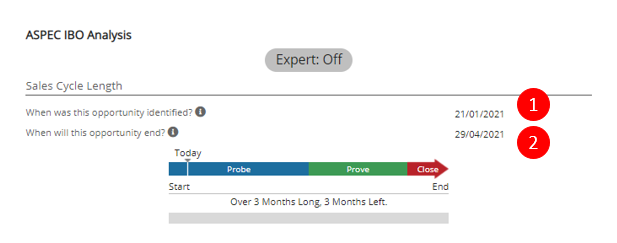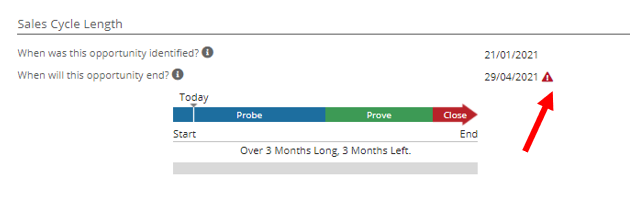ASPEC IBO Analysis is built into the Opportunity form. Users simply submit information about the progress of an Opportunity. ASPEC Advisor does the rest – as Opportunities are being worked on, ASPEC Advisor provides feedback on how well a salesperson is doing and offers strategic advice for improvement.
The only information (“IBO Essentials“) required by ASPEC Advisor is the salespersons answers to two simple questions about sales Probability, and the expected date of purchase for the opportunity. By considering sales probability and sales cycle phase, ASPEC Advisor is able to “understand” the situation and provide basic coaching on what to do next.
ASPEC Advisor can help users manage time more effectively by assigning a Priority level to each Opportunity. This way, opportunities can be worked on in order of importance and plan the next move strategically.
Start and End Date
The Date fields that capture the start (1) and the end (2) of the Sales Cycle on the IBO form are as follows:
 Fig 1: IBO Essentials Dates
Fig 1: IBO Essentials Dates
1: When was this opportunity identified: Pick the date that you first discovered this opportunity. The Start Date field is used to set the beginning of the sales cycle and indicates when this sales opportunity first came to be. The start date defaults to the current date and is usually best left as the current date. However, in some cases you may want to change the start date if you are entering the new IBO some time after you first become aware of it.
2: When will this opportunity end: This field sets the end date of the sales cycle for this opportunity. The value of this field is your best estimate of when this sale is going to close (ie. the customer has made their purchasing decision). Choosing an accurate date is important, as it sets the time window in which you have to sell your solution to the customer.
In Read mode ASPEC displays the number of changes to the “When will this opportunity end” date.

Fig 2: Click on the red triangle to examine the number of changes to the close date
Sales Cycle Graph
When you have entered the 2 dates, ASPEC will graphically display the sales cycle for this opportunity. Today will be marked by a graphical arrow.  Fig 3: Graphical representation of Sales Cycle
Fig 3: Graphical representation of Sales Cycle
Yellow dots represent IBO Interactions that have been entered into ASPEC.
3 Sales Phases – Probe, Prove, Close
Like any activity, a sales opportunity has a beginning, a middle, and an end. And you always need to know where you are because time passes whether you’re doing anything or not.
Just under the sales cycle diagram, you can see how long the sales cycle is, as well as how much time there is left before it ends. Each Sales Cycle is segmented into Probing, Proving and Closing – no matter how long the sales cycle is. The phases adjust to the expected date of winning the IBO and help prioritize the list of IBOs. They are related to the fundamental skills of selling – probing, proving and closing – that dominate each phase. All 3 skills are used to differing degrees, depending on the position in the sales cycle.
Probability
Once you’ve defined the sales cycle length, ASPEC will calculate a Probability for this IBO. Probability drives your activity, it measures your progress, and it guides the company toward success. And yet, it is almost impossible to determine with accuracy and consistency. Automated probability is a unique (and patented) feature of ASPEC, and it solves that problem, being easy and consistent to estimate.
Probability has only two factors – the likelihood that will the customer actually buy something, and the possibility that they will buy it from you.
In the Risk/Probability Assessment section use the dropdowns to enter your answers to the following two questions, by choosing from are High, Medium, and Low.

Fig 4: Risk/Probability Assessment questions and Probability Matrix
Question 1: Will we win this opportunity?
To clarify, if they do buy, will we win this opportunity? The answer to this question establishes the chances of the customer buying from you rather than the competition.
Question 2: Will this opportunity go through to completion?
The answer to this question establishes the chances of the customer making a purchase, from you or some other vendor. What is the chance that this customer will really buy something in the end? Not just from me, but from anyone. You’ll need to know something about their needs, their preferences, their budgets, decision-makers, etc. Based on the information you have at this early stage, make an estimate.
This question is often shortened to “Will It Happen.”
Pick answers from the drop-down lists, and you’ll see your selection on the “Probability Matrix” (3).
Based on the information you’ve provided, ASPEC calculates Probability.
Priority
Priority is the result of Probability and time. Today’s Priority for this IBO might be different tomorrow or the next day, even if you’ve done nothing, because time has passed and you’re closer to the end of the sales cycle.
ASPEC automatically assigns one of five Priority levels (besides Overdue) and changes them as time passes as you conduct your sales activities, providing you with real-world guidance on how to best manage your entire portfolio of opportunities.

Fig 5: IBO Priority set to 2
Example 1
What are your chances now, and how much time is there left for things to change?
If you’re in the Probe phase and select “High” and “High” as your estimates, then you have an 80% probability of winning and a lot of time until the close, so it’s recognized as a “Review Second”. That means pay attention so nothing slips by you, but this isn’t the most important IBO in your portfolio.
If you change the “Will We Win” field to “Low” your Probability goes down to 25%, but your Priority goes up to “Review First”. This becomes a priority because someone is going to win this sale, and unless you do something proactive, it won’t be you. Fortunately, you have plenty of time to correct that, but what if you don’t? Change the “End Date” to tomorrow and watch your “Priority” change. With very little time left, you will need to come up with a “Breakthrough” strategy and implement it or you’re at a loss.
Example 2
Consider another scenario: In the Probe phase of the sales cycle, the customer has expressed that funding would not yet be available. Even if funding materializes, the customer is favouring the competition. The rank assigned to “Will this opportunity go to completion?” and “Will we win this opportunity?” will be “Low” for both.
In the Probe phase, when there’s still plenty of time before the customer makes a decision, a Low/Low ranking would be discouraging, but not worth abandoning the sale altogether. However, in the Close phase, when the opportunity is nearing the end of the sales cycle, the same ranking would indicate the opportunity is almost definitely lost.
Example 3
Here is another example: An opportunity is so promising that it has been given a High/High ranking. The probability of winning this sale is high, so the opportunity requires less attention in the Probe phase. Instead, focus on the opportunities that require more work. The High/High ranked opportunity will later become a top priority in the Close phase when it’s time to get the deal done.
ASPEC Advisor
So far, you’ve entered the basic information and established the basis for ASPEC to help you effectively manage your opportunities. That’s the “engine” part of the Automated Sales Process Engine for the Computer. Pretty nice stuff, but it seems a little like the hybrid engine. Sure, it’s brand new technology and gets great mileage, but what if you want the big V8? Your sales are complex, your competition relentless, your goals almost unrealistic. You need all the power you can get.
Both Sales Advisor Pro and Sales Advisor Expert provide feedback on areas to focus on or watch out for regarding a given sale.
ASPEC IBO Analysis provides Sales Advisor Pro feedback as a default. Depending on the edition of ASPEC you are using, you may take advantage of Sales Advisor Expert for extra advice and guidance.
Sales Advisor Expert provides much more detailed feedback on potential problem areas in a given sale. It is useful in strategic sales that may involve competition or multiple decision makers. Sales Advisor Pro is useful in simpler sales where you may not need the extra coaching provided by Sales Advisor Expert.
Turning this on will enable an additional group of questions (“Sales Environment”), and will overlay the ASPEC Advisor Expert response for Probability and Priority in yellow.
Read more on Advisor Expert in this post.
For a more detailed description of ASPEC Sales Methodology please visit our website page: Sales Method